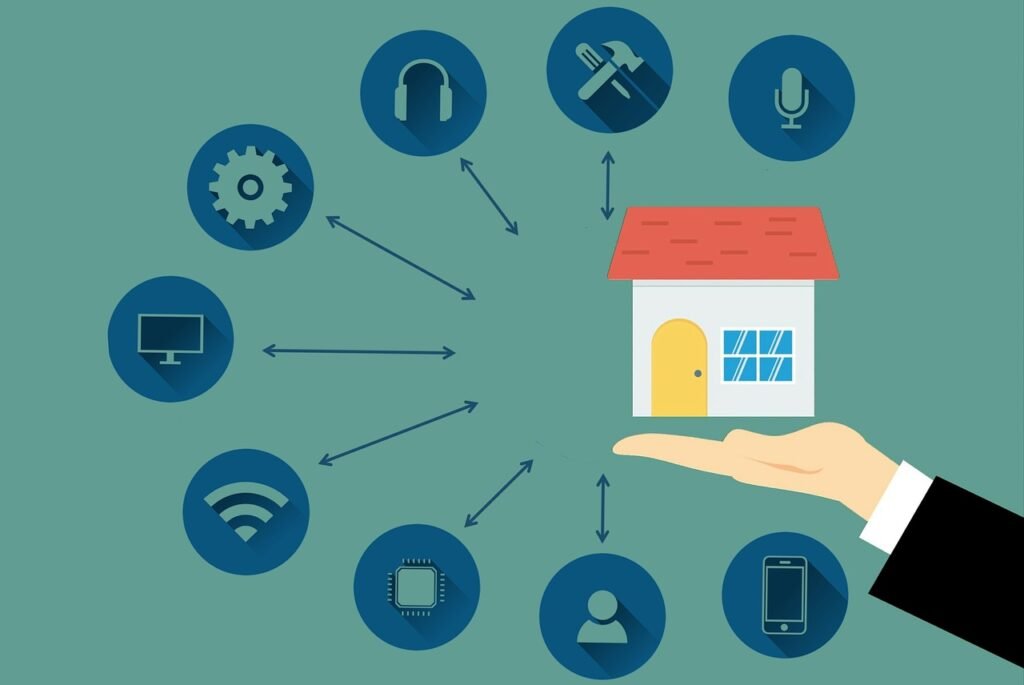Imagine a world where every room in your house is bathed in the perfect amount of light, tailored to your specific needs and preferences. Where your lights automatically adjust based on the time of day, saving you energy and money. Welcome to the future of lighting: smart lighting. In this article, we will explore how smart lighting technology is revolutionizing the way we illuminate our homes and businesses, enhancing energy efficiency and creating a more sustainable future. Say goodbye to wasted energy and hello to a brighter, smarter tomorrow.

This image is property of images.unsplash.com.
check out our product reviews
What is smart lighting?
Smart lighting refers to the use of advanced technologies and sensors to control and manage lighting systems in an intelligent way. It leverages the power of connectivity and automation to enhance energy efficiency, user comfort, and overall lighting performance. By integrating smart lighting technology, you can transform your lighting system into a dynamic and versatile solution that adapts to your needs and optimizes energy consumption.
Definition of smart lighting
Smart lighting refers to lighting systems that incorporate networked sensors, controls, and automation capabilities to provide enhanced functionality and energy efficiency. These systems can be remotely operated and controlled, allowing users to adjust lighting settings, schedule operations, and monitor energy consumption in real-time. By utilizing technologies like motion sensors, smart switches, and dimmers, as well as wireless connectivity, smart lighting offers a seamless and intelligent lighting experience.
Features and benefits of smart lighting
Smart lighting systems offer a wide range of features and benefits that go beyond traditional lighting solutions. Some key features include:
- Energy efficiency: Smart lighting systems have the ability to adjust lighting levels based on occupancy and daylight availability, reducing unnecessary energy consumption.
- Customizable settings: Users can personalize lighting settings to create the desired ambiance or match specific activities.
- Automated controls: Smart lighting allows for automated control of lighting systems, enabling lights to turn on/off based on occupancy or schedule.
- Real-time monitoring: Advanced monitoring features enable users to track and analyze energy consumption in real-time, facilitating energy optimization and cost savings.
- Longer lifespan: The use of LED bulbs in smart lighting systems increases the lifespan of lighting fixtures, reducing maintenance and replacement costs.
- Enhanced security: Smart lighting can be integrated with security systems, providing an added layer of safety by automatically turning lights on when motion is detected.
- Compatibility: Many smart lighting systems are designed to be compatible with existing infrastructure, making it easy to integrate them into both residential and commercial settings.
By leveraging these features, smart lighting offers numerous benefits such as reduced energy consumption, enhanced user comfort, and cost savings, making it an attractive option for both homeowners and businesses.
Understanding energy efficiency
To fully appreciate the benefits of smart lighting, it’s important to understand the concept of energy efficiency and its significance in the realm of lighting.
Definition of energy efficiency
Energy efficiency refers to the efficient use of energy to achieve a desired output or result. In the context of lighting, it involves maximizing light output while minimizing energy consumption. Energy-efficient lighting systems consume less electricity and produce less heat, resulting in a reduced environmental impact and lower energy costs.
Importance of energy efficiency
Energy efficiency is a crucial factor in today’s world, where the demand for energy continues to rise while resources become increasingly scarce. By adopting energy-efficient practices, such as implementing smart lighting systems, we can reduce our energy consumption, decrease greenhouse gas emissions, and mitigate the effects of global warming. Furthermore, energy efficiency also translates into economic benefits by lowering energy bills and operating costs.
Environmental impact of traditional lighting
Traditional lighting technologies, such as incandescent and fluorescent bulbs, are known for their inefficiency and high energy consumption. Incandescent bulbs convert only about 10% of the energy they consume into visible light, while the rest is wasted as heat. Similarly, fluorescent bulbs are not as efficient as their LED counterparts and contain toxic elements like mercury.
The environmental impact of traditional lighting includes increased energy consumption, higher carbon emissions, and the generation of hazardous waste. In contrast, smart lighting systems, particularly those utilizing LED bulbs, offer a significantly more energy-efficient alternative, helping to reduce our ecological footprint and minimize environmental harm.
Overall, understanding energy efficiency is crucial in realizing the benefits of smart lighting and making informed choices in favor of sustainable and efficient lighting solutions.

This image is property of images.unsplash.com.
check out our product reviews
Integration of smart lighting technology
The integration of smart lighting technology is revolutionizing the way we illuminate our spaces. By combining advanced sensors, controls, and connectivity, smart lighting systems offer an unparalleled level of intelligence and efficiency.
How smart lighting technology works
Smart lighting technology utilizes various components to create a connected lighting system. These components include LED bulbs, wireless communication protocols, smart switches/dimmers, and motion/occupancy sensors. The LED bulbs serve as the light source, providing excellent energy efficiency and longevity.
Wireless connectivity protocols, such as Wi-Fi, Bluetooth, or Zigbee, enable the communication between different components of the smart lighting system. This enables users to control the lighting remotely through smartphones, tablets, or voice assistants.
Smart switches and dimmers allow for manual control of lighting settings, while motion and occupancy sensors detect movement and adjust lighting accordingly. These sensors are particularly useful in areas where lights are frequently left on, such as hallways or bathrooms.
Advancements in smart lighting systems
Over the years, there have been significant advancements in smart lighting systems. The introduction of smart bulbs and fixtures, such as LED-based lighting solutions, has revolutionized the lighting industry. LED bulbs are highly energy-efficient, producing more light per watt and lasting significantly longer compared to traditional bulbs.
Moreover, the integration of advanced sensors and controls has made smart lighting systems even more sophisticated. With the emergence of machine learning and artificial intelligence, smart lighting can now analyze data in real-time, allowing for more precise control and optimization of lighting based on user preferences and occupancy patterns. This level of customization and automation presents a significant advancement in lighting technology.
Compatibility with existing infrastructure
One of the key advantages of smart lighting technology is its compatibility with existing electrical infrastructure. Many smart lighting systems are designed to be retrofit solutions, meaning they can easily replace traditional bulbs and fixtures. This allows for seamless integration into homes, offices, and other buildings without requiring extensive rewiring or infrastructure modifications.
Compatibility also extends to the control aspect of smart lighting. Most smart lighting systems can be controlled through mobile applications or cloud-based platforms, eliminating the need for complex control panels or additional wiring. Users can effortlessly integrate smart lighting into their existing smart home ecosystems and enjoy the benefits of enhanced lighting control and energy efficiency.
By offering compatibility with existing infrastructure, smart lighting technology simplifies the transition to energy-efficient lighting solutions, making it more accessible and appealing to a wider range of users.
Benefits of smart lighting for energy efficiency
Smart lighting offers a multitude of benefits specifically aimed at improving energy efficiency. By harnessing the power of automation, customization, and advanced controls, smart lighting systems optimize energy usage while providing enhanced functionality and user experience.
Reduced energy consumption
Perhaps the most significant benefit of smart lighting is its ability to reduce energy consumption. By utilizing advanced sensors and automation, smart lighting systems can adjust lighting levels based on occupancy and natural light availability. Lights can turn off automatically when no one is present in a room or adjust their brightness based on the amount of daylight entering the space. Such intelligent control helps minimize unnecessary energy consumption and lowers electricity bills.
Longer lifespan of LED bulbs
Smart lighting systems predominantly use LED bulbs, which are known for their extended lifespan compared to traditional incandescent or fluorescent bulbs. LED bulbs can last up to 25 times longer, significantly reducing maintenance and replacement costs. Their longevity, combined with energy efficiency, results in overall cost savings and reduced environmental impact.
Customizable lighting settings
Smart lighting allows users to personalize their lighting settings to create the right ambiance for every occasion. Whether it’s setting the mood for a cozy movie night or brightening up the workspace for productivity, smart lighting systems offer a wide range of options. Users can choose from different color temperatures, dimming levels, or even dynamic lighting scenes based on their preferences, enhancing user comfort while optimizing energy consumption.
Automated controls and sensors
Smart lighting systems integrate motion and occupancy sensors that automatically detect movement and turn lights on or off accordingly. This eliminates the need to manually switch lights on or off, reducing the chances of lights being left on unnecessarily. Automated controls also ensure that lights are only active when needed, further optimizing energy consumption and reducing the carbon footprint.
Real-time energy monitoring
With smart lighting systems, users can monitor their energy consumption in real-time through dedicated apps or online platforms. This transparency allows for better energy management and encourages more conscious usage habits. By analyzing energy usage data, users can identify areas of improvement, fine-tune settings, and make informed decisions to further enhance energy efficiency.
Lighting optimization through data analysis
Smart lighting systems have the capability to collect and analyze data, enabling users to optimize lighting based on patterns and preferences. By analyzing occupancy patterns, usage data, and ambient conditions, smart lighting systems can make intelligent decisions to deliver the right amount of light where and when it is needed. This data-driven approach not only enhances comfort but also contributes to significant energy savings by eliminating energy waste.
By combining these benefits, smart lighting systems empower users to achieve a balance between energy efficiency, comfort, and convenience.

This image is property of images.unsplash.com.
Applications and examples of smart lighting
Smart lighting technology finds applications in a wide range of settings, from homes to commercial spaces and public areas. Here are some examples of how smart lighting is being implemented:
Residential smart lighting solutions
In residential settings, smart lighting systems offer homeowners the ability to effortlessly control their lighting for various purposes. For instance, smart lighting can be programmed to gradually increase brightness in the morning to simulate natural sunlight, promoting a more natural wake-up routine.
Moreover, smart lighting systems can be integrated with home automation platforms, allowing users to control lighting through voice commands or intelligent automation. Features like “away mode” can automatically turn lights on and off while you’re away, giving the illusion of an occupied home and enhancing security.
Commercial and workplace implementations
Smart lighting is gaining popularity in commercial spaces, such as offices and retail stores, where lighting plays a crucial role in creating an inviting atmosphere and optimizing productivity. In these settings, smart lighting systems can be programmed to automatically adjust lighting levels based on occupancy and ambient conditions, optimizing energy consumption while ensuring a comfortable working environment.
Moreover, smart lighting systems can facilitate data collection and analysis to identify occupancy patterns, monitor energy consumption, and make data-based decisions for energy optimization. This provides valuable insights to facility managers, allowing them to make informed decisions regarding lighting upgrades, maintenance, and space utilization.
Smart lighting in public spaces
Smart lighting is also making its way into public spaces, such as streets, parks, and parking lots. By utilizing motion sensors and advanced controls, smart lighting systems can provide adequate lighting only when needed, reducing energy waste and saving costs for municipalities.
Furthermore, smart lighting systems can be integrated with environmental sensors to detect and respond to changes in weather or ambient conditions. For example, the lights can automatically adjust their brightness during daylight hours or in response to low visibility caused by fog or heavy rain, ensuring safety while minimizing energy consumption.
Outdoor and landscape lighting
In outdoor settings, smart lighting offers numerous possibilities for enhancing the aesthetics and security of a property. Through the integration of sensors and automation, outdoor smart lighting systems can adjust lighting levels based on ambient conditions, motion, or scheduled events.
For example, smart lighting in landscape settings can highlight specific features, such as trees or fountains, using dynamic or colored lighting effects. Additionally, outdoor smart lighting systems can be programmed to turn on at sunset and gradually dim to a lower level during the night, providing efficient and attractive illumination for pathways, gardens, or patio areas.
By showcasing these applications, it becomes evident that smart lighting offers versatile solutions for a variety of settings, enhancing both functionality and energy efficiency.
Smart lighting infrastructure and components
To fully understand smart lighting systems, it’s important to examine the various components and infrastructure that enable their operation.
LED bulbs and fixtures
At the core of smart lighting systems are LED bulbs and fixtures. LEDs, or Light-Emitting Diodes, are semiconductors that emit light when an electric current passes through them. LED bulbs are highly energy-efficient, consume less power, and have a significantly longer lifespan compared to traditional incandescent or fluorescent bulbs. These properties make them the ideal choice for smart lighting systems.
Smart lighting systems often utilize LED bulbs with built-in connectivity capabilities, allowing them to wirelessly communicate with other components of the system. These bulbs can be remotely controlled, dimmed, or even change color depending on user preferences.
Smart switches and dimmers
Smart switches and dimmers are essential components of smart lighting systems, enabling users to manually control lighting settings. These switches can be wirelessly connected to the smart lighting network, allowing for convenient control from various devices.
Smart dimmers offer the flexibility to adjust the brightness level of the lights, enhancing user comfort and flexibility. By setting the perfect lighting level for different activities, users can create the desired ambiance and save energy by avoiding excessive lighting.
Motion and occupancy sensors
Motion and occupancy sensors play a vital role in smart lighting systems by detecting movement and occupancy in a space. These sensors are typically installed in areas where lights are frequently left on, such as hallways, bathrooms, or conference rooms.
When motion is detected, the sensors send a signal to the smart lighting system to turn on the lights. If no movement is detected for a certain period, the lights automatically turn off, ensuring that lights are only active when needed. This automation feature significantly contributes to energy savings and reduces the chances of lights being accidentally left on.
Wireless connectivity and protocols
To enable seamless communication between different components of the smart lighting system, wireless connectivity and protocols are utilized. Wi-Fi, Bluetooth, and Zigbee are some of the common wireless protocols used in smart lighting.
These protocols allow the bulbs, switches, sensors, and other components to communicate with each other and with external devices, such as smartphones or voice assistants. This connectivity enables users to control their lighting system remotely, adjust settings, or integrate it into their existing smart home or building automation systems.
Smart lighting control systems
Smart lighting control systems serve as the brain of the entire lighting network. These systems are responsible for managing all the connected components, enabling users to control and monitor the lighting system as a whole.
Control systems provide users with a user-friendly interface, usually in the form of mobile apps or web-based platforms, allowing them to adjust lighting settings, create schedules, or monitor energy consumption. These platforms also offer advanced features, such as scene creation, where users can save and recall a specific combination of lighting settings to match their preferences or activities.
By combining these components and infrastructure, smart lighting systems offer a comprehensive solution that transforms the way we use and control lighting.
Factors to consider before implementing smart lighting
Before implementing smart lighting systems, several important factors should be considered to ensure a successful integration and optimize the benefits. These factors include:
Initial cost and return on investment
While smart lighting systems can deliver significant energy savings in the long run, the initial cost of investment can be higher compared to traditional lighting solutions. It’s essential to evaluate the upfront costs, including the cost of smart bulbs/fixtures, installation, and any additional hardware or software requirements.
However, it’s equally important to consider the long-term return on investment (ROI) potential. The energy savings and reduced maintenance costs achieved through smart lighting systems can potentially outweigh the initial investment, resulting in significant cost savings over the system’s lifespan.
Compatibility with existing electrical systems
Before implementing smart lighting, it is crucial to assess the compatibility with existing electrical systems. Ideally, smart lighting systems should be designed as retrofit solutions, allowing for easy installation and integration with the existing infrastructure.
Compatibility considerations should include the existing wiring, voltage requirements, and the ability to connect with the available wireless network or protocols. By ensuring compatibility, unnecessary rewiring or infrastructure modifications can be avoided, making the implementation process smoother and more cost-effective.
User experience and convenience
The user experience and convenience offered by the smart lighting system are significant factors to consider. Intuitive controls, easy-to-use mobile apps, and compatibility with voice assistants are some features that enhance the user experience.
It’s important to ensure that the smart lighting system provides a seamless and user-friendly interface that aligns with the user’s preferences and lifestyle. Additionally, the system should offer features such as personalized lighting settings, scene creation, and scheduling options to maximize convenience and customization.
Scalability and expandability
Scalability and expandability are important considerations for future-proofing the smart lighting system. As needs and preferences change over time, the lighting system should have the flexibility to adapt and accommodate new requirements.
Whether it’s adding new fixtures, integrating with other smart home devices, or expanding the system to cover additional areas, the smart lighting system should be easily scalable. Assessing the expandability options upfront ensures that the system can grow with the user’s needs without the need for significant modifications or replacements.
Security and privacy concerns
With the increasing connectivity of smart devices, security and privacy concerns have become more prevalent. It is essential to consider the security features and protocols offered by the smart lighting system.
Ensure that the system provides secure data transmission, password protection, and encryption to safeguard user information and prevent unauthorized access. Additionally, it’s important to review the privacy policy of the smart lighting manufacturer to understand how data is collected, used, and shared.
By addressing these factors before implementation, users can make informed decisions and choose a smart lighting solution that best suits their needs, preferences, and long-term goals.
Case studies on energy efficiency with smart lighting
Numerous case studies have demonstrated the positive impact of smart lighting on energy efficiency. These studies highlight successful implementations and the resulting benefits in various settings.
Successful energy-saving projects
One notable case study is the Empire State Building retrofit, where smart lighting played a significant role in reducing energy consumption. Through the installation of smart lighting controls, LED fixtures, and daylight harvesting sensors, the building achieved a 38% reduction in lighting energy usage, resulting in millions of dollars in annual energy savings.
Another example is the Municipality of Anchorage in Alaska, which replaced traditional streetlights with smart LED lighting systems. By leveraging motion sensors and advanced controls, the municipality achieved energy savings of up to 50% compared to the previous lighting system. The retrofit not only reduced energy consumption but also enhanced visibility and safety for the community.
Cost-effective implementation strategies
In addition to significant energy savings, smart lighting projects have showcased cost-effective implementation strategies. The City of Los Angeles implemented a smart lighting system that replaced traditional streetlights with LED fixtures equipped with wireless controls. By leveraging the existing infrastructure and retrofitting the lights, the city achieved energy savings of over 63%, resulting in annual cost savings of approximately $9 million.
Similarly, the University of California, Davis implemented a comprehensive smart lighting project in its parking lots. By utilizing occupancy sensors and wireless controls, the university reduced lighting energy consumption by 61%, resulting in significant cost savings. The project demonstrated that smart lighting can be implemented effectively and affordably in large-scale environments, providing a compelling business case for further adoption.
Positive impact on energy bill reduction
Smart lighting systems have consistently demonstrated their ability to reduce electricity bills through energy-efficient operation. For instance, a study conducted in a Danish office building found that the implementation of smart lighting resulted in an 87% reduction in lighting energy consumption, translating into a 90% reduction in the lighting portion of the electricity bill.
Similarly, a case study in a hotel in Sweden showcased that the installation of smart lighting controls and occupancy sensors led to a 75% reduction in lighting energy usage. The reduced energy consumption resulted in substantial savings on the hotel’s energy bills, contributing to a more sustainable and cost-effective operation.
These case studies demonstrate the significant energy and cost savings potential of smart lighting systems, making them an attractive choice for businesses, municipalities, and individuals alike.
Government initiatives and regulations
Governments worldwide are recognizing the importance of energy efficiency and incentivizing the adoption of sustainable lighting practices through various initiatives and regulations.
Incentives and rebates for energy-efficient lighting
Many governments and utility companies offer incentives and rebates to encourage the adoption of energy-efficient lighting solutions, including smart lighting systems. These programs aim to offset the initial investment cost and accelerate the transition to more sustainable lighting technologies.
Incentives can take the form of cash rebates, tax incentives, or subsidized pricing for energy-efficient lighting products. By taking advantage of these incentives, businesses and consumers can reduce the financial barriers associated with implementing smart lighting systems, making them more accessible and affordable.
Energy efficiency standards and labels
Governments often establish energy efficiency standards and labels for lighting products to ensure quality, performance, and energy savings. These standards and labels provide consumers with valuable information about the energy efficiency of different lighting products, allowing them to make informed choices.
For example, the Energy Star program in the United States certifies energy-efficient lighting products, including smart lighting systems, that meet the program’s stringent standards. The Energy Star label helps consumers identify products that deliver energy savings without compromising performance or quality.
Collaboration with utility companies
Governments collaborate with utility companies to promote energy-efficient practices, including the adoption of smart lighting. These collaborations involve initiatives such as providing energy audits and consultations to businesses, offering energy-saving tips, and implementing demand response programs.
Utility companies also play a crucial role in providing support and guidance to consumers interested in implementing smart lighting systems. Through educational programs, workshops, and financial incentives, utility companies help consumers make informed decisions and realize the benefits of energy-efficient lighting.
By implementing these initiatives and regulations, governments are driving the widespread adoption of smart lighting systems, contributing to global energy savings and environmental sustainability.
Conclusion
Smart lighting technology is transforming the way we illuminate our spaces, offering a wide range of benefits for energy efficiency, user comfort, and lighting control. By combining advanced sensors, controls, and connectivity, smart lighting systems provide intelligent solutions that adapt to user preferences, optimize energy consumption, and reduce environmental impact.
Through reduced energy consumption, longer lifespan of LED bulbs, automated controls, customizable lighting settings, and real-time energy monitoring, smart lighting systems offer significant advantages over traditional lighting solutions. Moreover, the integration of smart lighting technology into various settings, such as residential, commercial, and public spaces, enables energy savings and enhanced functionality.
With their compatibility with existing infrastructure, scalability, and expandability, smart lighting systems make the transition to energy-efficient lighting more accessible and appealing. Factors such as initial cost, compatibility with existing electrical systems, user experience, and security concerns should be considered before implementing smart lighting.
Case studies have demonstrated the successful implementation of smart lighting systems, showcasing their impact on energy savings and cost reduction. Additionally, government initiatives and regulations, including incentives, energy efficiency standards, and collaborations with utility companies, are driving the widespread adoption of smart lighting.
As smart lighting technology continues to evolve, further developments and innovations are expected in the field, promising even greater energy efficiency and user benefits. By embracing the potential of smart lighting, individuals and organizations can contribute to a more sustainable future while enjoying the advantages of efficient and intelligent lighting solutions.
check out our product reviews


























